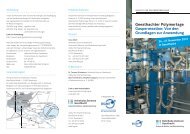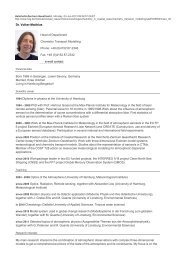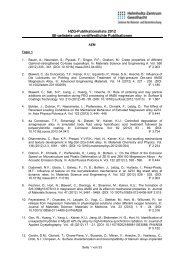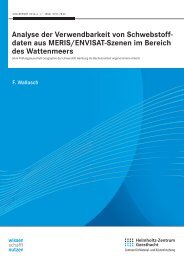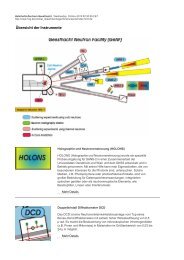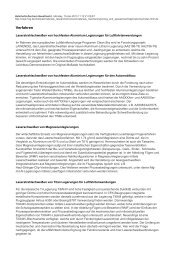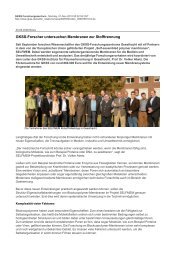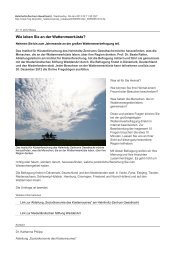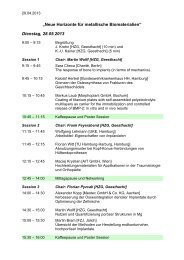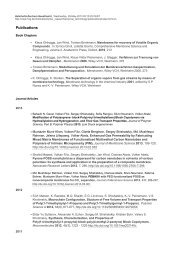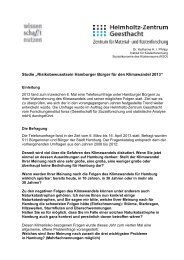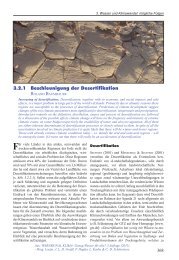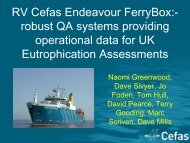High-resolution wave climate analysis in the Helgoland area - GKSS
High-resolution wave climate analysis in the Helgoland area - GKSS
High-resolution wave climate analysis in the Helgoland area - GKSS
Create successful ePaper yourself
Turn your PDF publications into a flip-book with our unique Google optimized e-Paper software.
2.2 Model validation 15<br />
provided by <strong>the</strong> BSH (Bundesamt für Seeschiffahrt und Hydrographie) <strong>wave</strong>rider buoy<br />
located approximately one kilometer south-west from <strong>the</strong> island. The water depth <strong>the</strong>re is<br />
about 20 m. The measured quantities comprise 9 parameters from which significant <strong>wave</strong><br />
height, peak period and mean direction for <strong>the</strong> period from March 1998 to October 2001 are<br />
used for <strong>the</strong> comparison with <strong>the</strong> K-model results. Ano<strong>the</strong>r data source is <strong>the</strong> WaMoS II<br />
(Wave and Surface Current Monitor<strong>in</strong>g System) radar (Hessner et al. [2001]) permanently<br />
mounted on a telecommunication tower on <strong>the</strong> ma<strong>in</strong> island s<strong>in</strong>ce March 1998 and provid<strong>in</strong>g<br />
<strong>wave</strong> parameters averaged over <strong>the</strong> rectangular surface <strong>area</strong> <strong>in</strong> a distance of about 500 m<br />
south-west from <strong>the</strong> islands (Fig. 2.1).<br />
Figure 2.5: H<strong>in</strong>dcast (KMH) and observed <strong>wave</strong> parameters at DWP and <strong>the</strong> central po<strong>in</strong>t from<br />
<strong>the</strong> <strong>area</strong> covered by radar measurements for October 1998. From top to bottom: significant <strong>wave</strong><br />
height <strong>in</strong> meters, peak period <strong>in</strong> seconds and mean direction (com<strong>in</strong>g from) <strong>in</strong> degrees. Buoy<br />
measurements are shown as crosses, radar measurements are shown as circles. The K-model<br />
h<strong>in</strong>dcast at <strong>the</strong> buoy (DWP) location is given by a blue l<strong>in</strong>e; h<strong>in</strong>dcast at <strong>the</strong> central po<strong>in</strong>t of radar<br />
rectangular is given by a th<strong>in</strong> brown l<strong>in</strong>e.<br />
At first, to assess <strong>the</strong> quality of modeled <strong>in</strong>stantaneous values with respect to observations,<br />
significant <strong>wave</strong> heights, peak periods and mean directions from all three data sources<br />
(K-model, buoy and radar) were compared for October 1998 (Fig. 2.5) and <strong>in</strong> general a good<br />
agreement between all datasets can be <strong>in</strong>ferred. A closer look at differences provides a reasonable<br />
explanation for <strong>the</strong> major part of <strong>the</strong>m. At <strong>the</strong> first decade of exam<strong>in</strong>ed month <strong>the</strong>



